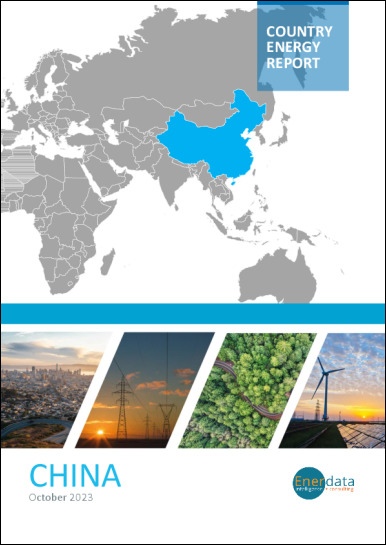- Update
-
- Format
- 4 files (PDF report, 3 Excel files)
- Pages
-
56 (Report only)
- Delivery
- Immediate by e-mail
- GENERAL OVERVIEW
- INSTITUTIONS AND ENERGY POLICY
- ENERGY COMPANIES
- ENERGY SUPPLY
- ENERGY PRICES
- ENERGY CONSUMPTION
- ISSUES AND PROSPECTS
- DATA TABLES
- ABBREVIATIONS
- GLOSSARY
Buy China energy report
Price without VAT. Depending on your statute and location, VAT might be applicable. Get in touch with us for more information.
After validation, you will immediately receive 4 files by email (one pdf report and 3 excel files containing the datasets).
Overview
This analysis includes a comprehensive China energy market report and updated datasets. It is derived from the most recent key economic indicators, supply and demand factors, oil and gas pricing trends and major energy issues and developments surrounding the energy industry. The report provides a complete picture of the country situation, dynamics, current issues and future prospects. With market data and continuous follow-up of markets news, this report brings clear and concise insights with which to tackle national energy challenges and opportunities. Browse the tabs below for a detailed table of contents, the list of graphs and tables, and details on the data files.
Highlights
- China intends to supply 20% of its total energy consumption from non-fossil fuels in 2025, to achieve peak CO2 emissions before 2030, and to reach carbon neutrality in 2060.
- Large state-owned organisations operate in the electricity and hydrocarbon sectors.
- CNPC dominates oil and gas production, with 50% of total output.
- CEIC and China Huaneng are the largest power generators, with almost 30% of total production.
- Solar capacity increased by 55% in 2023 and now represents 21% of the total capacity.
- The share of coal in the power mix has decreased by 15 points since 2010, reaching 62% in 2023, while the share of carbon-free electricity rose by 14 points to 34%.
- In 2020, market-based pricing was introduced for industrial electricity users.
- Gas prices in industry are similar to Japan and Korea, but much lower for households.
- Annual growth in total energy consumption was almost two times faster in 2023 (+7%) than over 2019- 2022.
- Coal dominates the energy mix (62% in 2023), but its share is decreasing rapidly (-9 points since 2010).
- Electricity is the main energy source for final consumers with a 30% share (+11 points since 2010).
- Although subsidy cuts have been announced, renewables are still attracting investors with large-scale projects.
- Despite a cap on coal mine production, new projects continue to increase the coal capacity.
Institutions & Energy Policy
NEA, the National Energy Administration, coordinates the national energy policy, manages energy conservation, and provides guidance about the integrated use of resources. It is a department of NDRC, the National Development and Reform Commission of the China State Council. NDRC formulates and implements medium and long-term strategies on social and economic development.
Energy Companies
Oil:
The oil sector is dominated by three state-owned companies: CNPC (China National Petroleum Corp), Sinopec (China Petroleum and Chemical Corporation), and CNOOC (China National Offshore Oil Corporation). CNPC and Sinopec are vertically integrated.
Energy Supply
Oil:
Oil production has been increasing since 2019 (+1.8%/year), reaching 209 Mt in 2023. It declined by 3%/year between 2015 and 2018, after increasing by 2%/year between 2000 and 2015. Most of the production is onshore and located in the fields close to the north-eastern coast. Offshore production is in full development, with the Bohai basin being one of the most active areas.
Energy Prices
Gas:
Residential gas prices are fixed by local authorities and capped, whereas industry prices are made of a benchmark price component and a fluctuation component (+20% deviation from benchmark price, downwards deviation not limited).
Energy Consumption
Total energy consumption per capita is increasing regularly, reaching 2.9 toe/cap in 2023 (nearly 4 times that for India). Electricity consumption per capita increased by nearly 7% to 5 944 kWh in 2023, more than twice the 2010 levels.
Graph: CONSUMPTION TRENDS BY ENERGY SOURCE (Mtoe)
Issues & Prospects
The main priorities are to increase production, diversify the supply sources (for security reasons), and tackle rising emissions. The country also continues to reform the electricity sector.
 Energy and Climate Databases
Energy and Climate Databases Market Analysis
Market Analysis